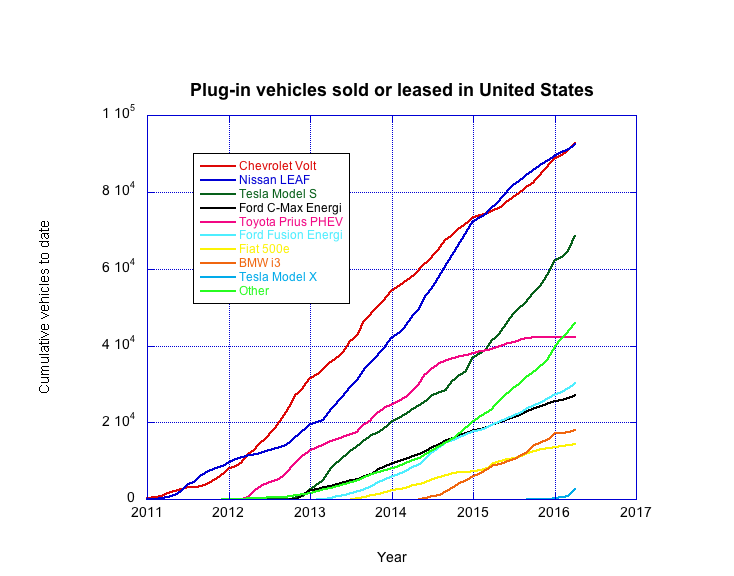
Home - Misc.: Tesla Model 3 Context
The Tesla electric-car company rarely if ever displays its vehicles at mainstream auto shows; they don't need to, in order to "move product." On March 31, 2016, they went one better and opened reservations for their Model 3, an affordable 200-mile-range pure battery-electric vehicle that isn't even out of prototype yet, and the response was incredible. Reservations were opened early to current owners of Tesla vehicles (the Roadster, the Model S sedan, and the Model X SUV); then as each Tesla showroom opened for business that day they began to take in-person reservations (with long lines at every location that I've heard from); and then, after a prototype of the vehicle was finally unveiled that evening, Internet reservations went online. 115,000 people put down a $1000 refundable deposit before the unveiling -- that is, before prospective buyers had actually even seen the vehicle! -- and the number about tripled to 300,000 in the first two or three days afterward. (I am told it reached about 400,000 in a month.)
This event, I think, truly marks the arrival of battery-electric vehicles into the mainstream; while these were only refundable deposits, not sales contracts, Plug in America pointed out that the sheer number of 300,000 compares favorably with the annual sales of the best-selling car in the country, the Toyota Camry, at 430,000 for all of 2015. To show how this expands the market for plug-in vehicles, I present here a plot of the cumulative sales to date of plug-in vehicles in the United States from the introduction in December 2010 of the Chevrolet Volt and Nissan LEAF through the end of March 2016. The heavy lifting to assemble these numbers was done by InsideEVs; they research monthly sales for each individual vehicle available in the United States, and all I have done here is to sum these into cumulative totals.

The chart above shows totals for those models that had broken the 10,000 vehicle threshold by the end of 2015 plus the Tesla Model X, which is on pace to do so by the end of 2016. The chart tops out at 100,000, well below the number of deposits people have put down on the Model 3. Looked at another way, the Fiat 500e is a big enough hit to have made it out of the "Other" category on this chart; its current MSRP is $31,800, and 14,476 of them had been sold or leased through March 2016. That's about $460 million in gross sales revenue for that model over about three years, which is only half again as large as the $300 million or more that Tesla raked in during three days or so, just in deposits!
Tesla have said that their factory, which currently occupies a small fraction of the former GM/Toyota plant in Fremont, California, could be ramped up to produce 500,000 vehicles a year; that would be a big expansion, to be sure... However, it is clear that the Model 3 will blow through the roof of the chart above as fast as Tesla can build them, if a substantial fraction of people convert their deposits to purchases! And that's not a big "if". Apologists for GM's abandonment of the EV1 electric car from the late 1990s were fond of talking about the "fact" that of 5000 people on a waiting list, only 50 followed through to a lease when offered the chance (though this assertion omits certain truths), and if only something like 1% of those 300,000 deposits were redeemed, well, the Model 3 wouldn't even make it onto this chart. However, remember that these aren't "hand raisers" -- each of those 300,000 people coughed up a grand, which is more than I for one can spare "on spec." These folks are serious, and numerous; that bodes well for Tesla, and for the Chevrolet Bolt with similar range and price (though very different looks, and we don't know about comparative performance yet), and for other next-generation models yet to debut.
Over twenty years ago, in the May 30, 1994 issue of "Business Week," I read that Chrysler thought that battery-electric vehicles could be built at the same cost as comparable gasoline vehicles if volumes reached 300,000 per year. That figure didn't include batteries, but the cost of those could be balanced against fuel savings over the life of the vehicle, and the comparison would only get more attractive as costs continued to come down for electric vehicles; more recently, I heard of an estimate (though I don't have a reference) that the retail cost including batteries would reach parity in about 2020. Between this and the increasing range of affordable electric vehicles, I wonder if the market for plug-in hybrids (PHEVs) like the Chevrolet Volt will start to wither; who needs the added complexity of a gasoline engine if a battery-electric can cover all the driving needs of the purchaser, including range? I think of the abortive modern renaissance of the electric vehicle from about 1996-2003 as the Who Killed the Electric Car? era, and the resurgence from 2008 to the present as the Revenge of the Electric Car era. Will we be able to look back and file 2016 as the start of the "Triumph of the Electric Car"? I'll keep a version of the above plot updated on another webpage, along with another plot breaking down the "Other" entry in this one; keep an eye on it!
 Back
to Fueling Station
Back
to Fueling Station Site
Map
Site
Map Contact
Me
Contact
Me All content copyright 1998-2024 by Mark Looper, except as noted. Reuse of my copyrighted material is authorized under Creative Commons Attribution 4.0 International license (CC BY 4.0).
![]()
![]()
new 1 May 2016